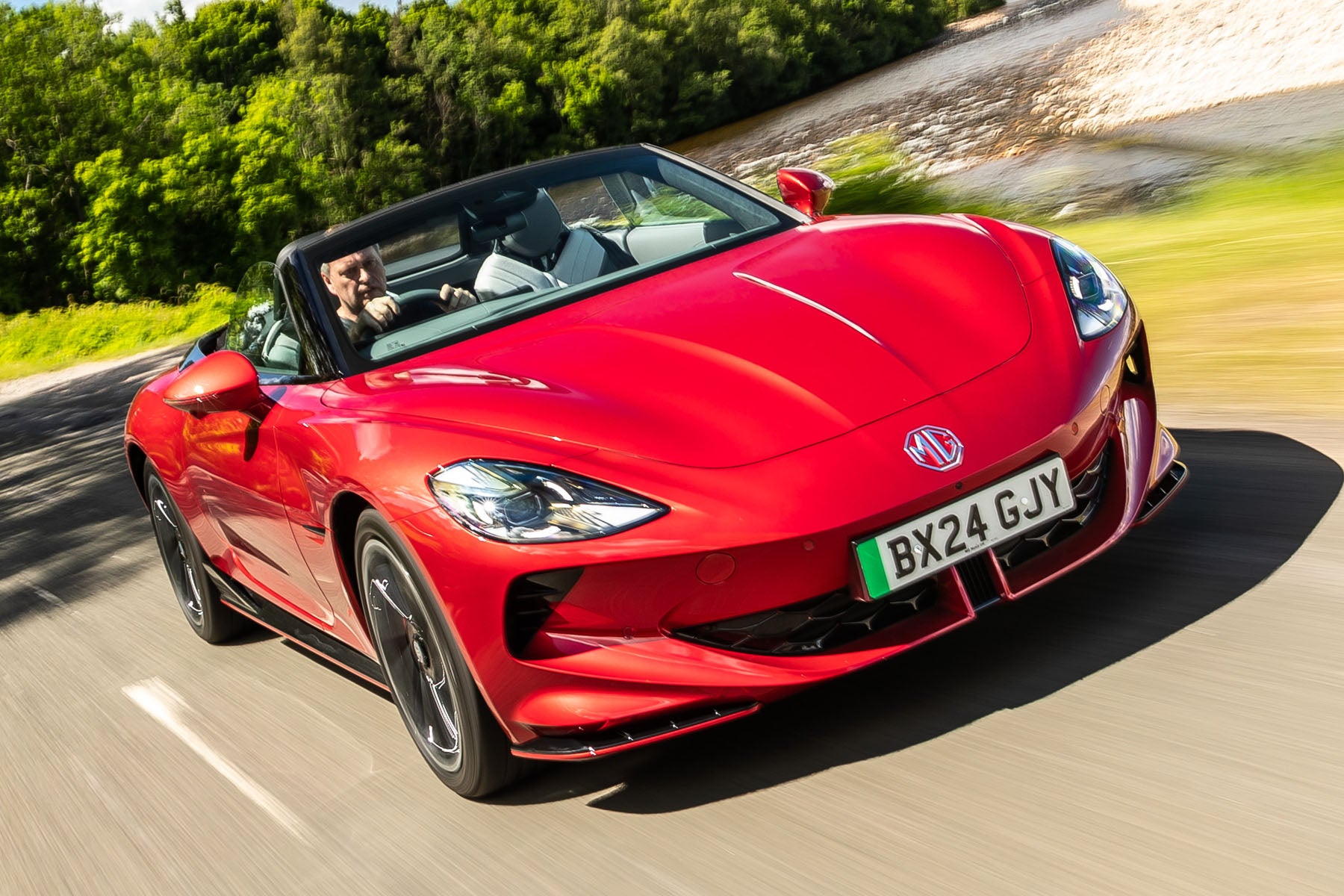MG Cyberster Review 2024
Written by Ivan Aistrop
Quick overview
Pros
- Exotic looks, complete with scissor doors
- Good interior quality
- Lots of standard equipment
Cons
- Infotainment arrangement is way too complex
- Not as good to drive as it is to look at
- Range is a little average
Overall verdict on the MG Cyberster
“If you’re old enough, you’ll probably remember the days when MG was famous for those gorgeous little two-seat classic roadsters that used to bimble around the British countryside on a Sunday afternoon, spreading smiles, goodwill and petrol fumes wherever they went.”
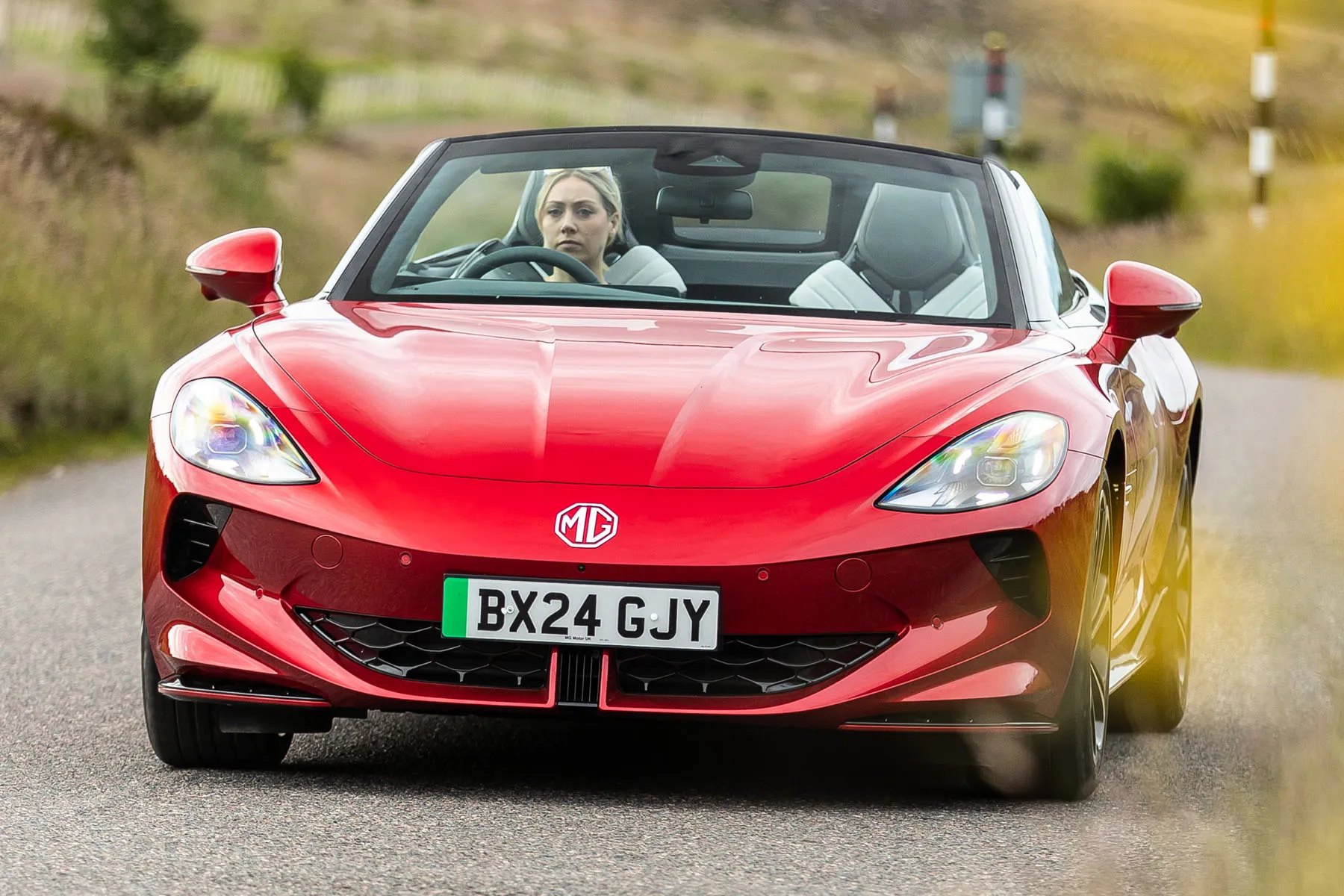
Sadly, those days have long since been consigned to the history books. Following the collapse of the company in the early noughties, what remained was bought up by new Chinese owners, and ever since, the company has been punting out humdrum hatchbacks and SUVs that major on value-for-money, with low prices and generous equipment list.
Until the last few years, that is. The company’s last few efforts - including the MG4 hatchback and MG5 estate - have had much more going for them than just that, with distinct progress being made in various areas including quality, technology and driving experience. The company’s electric car offerings have been particularly successful in forming a dedicated following with buyers. This is very much a company on the up, and the UK sales charts reflect that, with great strides being made on that score in recent years.
Such is the company’s confidence right now that it has decided it’s time for a return to the glory days of the past, but in a way that’s entirely appropriate for the future. Say hello, then, to the MG Cyberster, a two-door, two-seat all-electric convertible sports car that looks the absolute business, with bold, muscular styling and theatrical scissor doors. Not so humdrum now, huh?!
Two distinct flavours are offered. The entry-level Trophy has a rear-mounted electric motor delivering 340PS for a 0-62mph time of 5.0 seconds, while the GT version adds another electric motor on the front axle for four-wheel drive and 510PS, enough to power it from 0-62mph in 3.2 seconds.
The sports car looks are matched by sports car performance, then, but does it provide sports car handling to match? Well, yes and no, as we’ll discover in more detail later. It’s certainly fun, that’s for sure but in an unruly kind of a way rather than being pin-sharp and precise.
There are a few other flaws, too. The driving position is a bit high, the practicality is predictably limited and MG has tried to be too clever with the infotainment system. It features no fewer than four digital screens, and it’s so complicated that you’ll need the multitasking ability of a world-class plate-spinner to be able to use it safely while driving.
However, there’s plenty of other stuff you’ll like. The interior looks and feels fab, there’s a massive amount of standard equipment provided as standard, and even the pricing doesn’t look too bonkers. Run it as a company car, and you’ll pay a pittance in company car tax - thanks to it being an electric car - to run one of the most glamorous-looking cars on the road.
Probably the most appealing thing about the Cyberster, though, is that it’s truly unique. Name another two-seat all-electric convertible sports car available on the new car market, we dare you. Spoiler alert: you can’t, because there isn’t one.
Is the MG Cyberster right for you?
If you want a convertible sports car that happens to be electric, then yes, because it’s just about the only one you can buy right now. Tesla has been promising a second-generation Tesla Roadster for several years now, but it still hasn’t materialised, and we’re beginning to wonder whether it ever will. The canniest Cyberster customers will be those wanting a stylish and glamorous company car. They’ll get what they asked for in spades, and thanks to the low benefit-in-kind tax rates currently available on electric cars, they’ll pay very little for the privilege.
What’s the best MG Cyberster model/engine to choose?
For us, it’s the range-topping GT version. OK, so it’s more expensive than the entry-level Trophy model (albeit by only five grand), and comes with pretty much exactly the same level of equipment. It also has a shorter range, and looks visually indistinguishable from the standard car. However, it’s a considerably sweeter car to drive, and not only because it has an additional electric motor that gives it four-wheel drive and a power hike from 340PS to 510PS. No, it’s also because the suspension feels more tied down - we suspect due to the additional 100kg it’s carrying - making it a more composed car in terms of both ride and handling.
What other cars are similar to the MG Cyberster?
None, to be honest. The Cyberster really is like nothing else on the road, and that makes it the best car of its type by default.
There are combustion-engined two-seat convertibles, such as the BMW Z4 and Porsche Boxster, that might also compete for your cash, while there are solid-roofed sporty electric cars like the Porsche Taycan and Audi E-Tron GT, but no car matches up with the Cyberster precise in terms of size, seats, bodystyle, powertrain, and price.
Comfort and design: MG Cyberster interior
“The dashboard of the MG Cyberster is dominated by the four (yes, four!) digital screens you’re faced with. We’ll talk more about these in the Infotainment section in a moment: stick around, because we have plenty to say…”
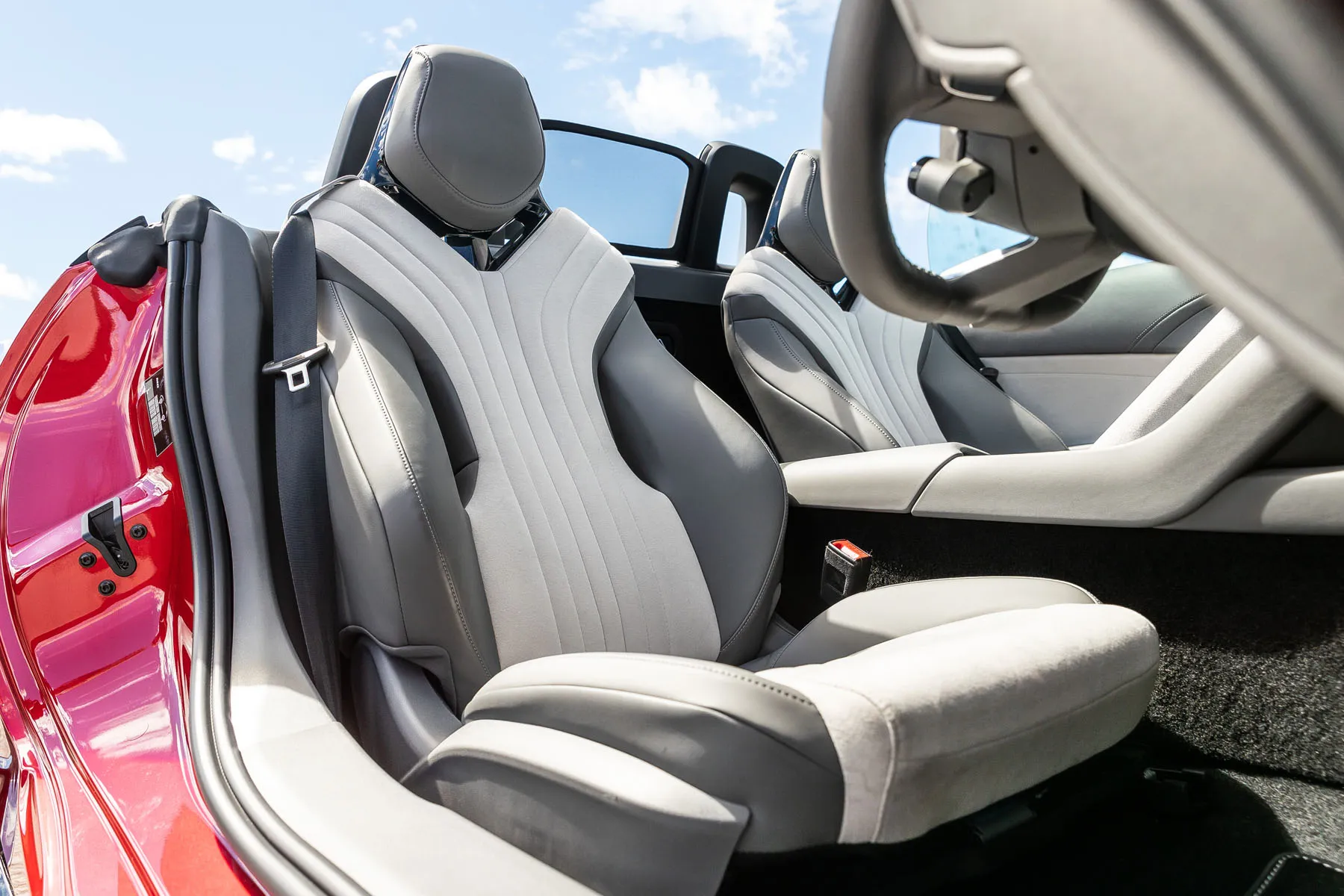
In both versions of the car, the chairs are adjusted electrically, giving you lots of precision in setting your desired seating position. However, even with the seats set to their lowest position, you sit up quite high in the Cyberster, which doesn’t feel quite right in a sporty-feeling car like this. The steering column moves manually in two planes to help you find a comfortable driving position, but you might wish for a greater range of movement.
That high seating position might also make some taller drivers feel like their heads are sitting in rather close proximity to the top of the steeply raked windscreen, which can make them feel a tiny bit hemmed-in. The steep angle of the windscreen can also mean that the pillars either side of it can block your view slightly at junctions. The rollover hoops and wind deflector can also limit your rear view a bit, but it’s not too bad.
The scissor doors certainly look very glamorous and theatrical, and although they don’t make getting in and out any easier, they don’t make it any harder, either. We haven’t tried doing that in a tight multistorey parking space, though, admittedly. The fully electric opening and closing mechanism is a bit slow, too.
Quality and finish
With MG’s plight over the last couple of decades, and the budget-focused approach it’s had to take in order to survive, many see it as something of a bargain-basement brand these days. However, when you’re spending a minimum of £55,000 on your convertible that everyone can see into, you really don’t want it to have a budget interior. Happily, the Cyberster really doesn’t.
Most of the materials you come across look and feel of an appropriately high grade, and there’s a nice mixture of trim pieces, textures and finishes that makes the cabin interesting and pleasant to look at. The numerous digital screens also help things feel appropriately space-age.
OK, things aren’t perfect. A couple of parts - the wiper- and indicator stalls, for example - have a bit of a cheap-and-cheerful finish to them, while a few of the switches have a slightly flimsy feel in the way they operate. However, these shortcomings are neither numerous enough, nor severe enough, to ruin the overall illusion.
Infotainment: Touchscreen, USB, nav and stereo in the MG Cyberster
As we mentioned earlier, the Cyberster’s dashboard comes festooned with no fewer than four digital screens. There’s a 10.25-inch one directly behind the steering wheel that acts as your instrument panel, and either side of this sit two 7.0-inch touchscreen displays, and the whole arrangement is supposed to wrap around the driver.
The screen on the left takes care of your nav and entertainment functions, while the one on the right provides various snippets of information about energy usage, battery charge level, weather information, the whereabouts of local MG service centres, and more. The final touchscreen sits in the middle of the dashboard, and this allows you to switch between various car settings - driving modes, safety systems, lighting, seat settings, and more - and operate the finer points of the climate control system. Happily, there is a separate bank of touch-sensitive climate control buttons just above the screen, so you don’t always have to go delving into on-screen menus to perform basic functions.
Now, all of that sounds great in theory, and admittedly, it does look pretty cool on first encounter. The instant you attempt to try and actually use the system, though, you’ll realise how monumentally difficult it is to do so.
Firstly, the menus are arranged in tabbed submenus, which you swipe between horizontally. Granted, this gives you a fighting chance of finding the function you want, but the act of swiping itself is a fiddly business (you have to put your finger in exactly the right place on the screen, which requires too much concentration), and many often-used functions are buried too deep within the submenus. And that’s before you factor in the fact that, even before you get to this stage, you have to remember which of the myriad screens you need to use to access a particular function.
And there’s more. Large portions of the two 7.0-inch screens are obscured by the top corners of the steering wheel, so you can’t see them properly without craning your neck sideways. There’s even a problem with the separate climate controls: the touch-sensitive buttons aren’t all that sensitive, and often fail to register an input unless you press really hard, and even then, it’s hit and miss. The same can be said for some of the graphics, which look good in most cases, but the screen transitions can often be a little glitchy.
In short, the whole system is way too complicated, and even performing the simplest of functions can be a thoroughly bamboozling process. Even worse, the amount of concentration needed to navigate your way through the system diverts your attention from the road for far too long, far too often. And if you weren’t already painfully aware of that fact, you’ll be informed by the car’s attention assist warning system which, as soon as you start trying to hunt around for a particular function, immediately scolds you for not concentrating enough on the road ahead.
Space and practicality: MG Cyberster boot space
Those seeking ultimate practicality are rarely the same people who choose to buy two-seater open-topped sports cars - electric or otherwise - so it’s entirely forgivable that the MG Cyberster doesn’t provide it.
The two seats are surrounded by enough space to accommodate a pair of tall adults in comfort, and depending on how far back your seats need to be set on their runners, there’s space behind them to carry a small amount of stuff, although the narrow shape of the space means it’ll be for coats and jumpers, rather than bags.
That aside, there isn’t a huge amount of cabin storage. There’s a small glovebox underneath the dashboard in front of the passenger seat, a lidded cubby under the central armrest and a couple of cupholders in the centre console, but that’s about your lot. The glamorous scissor doors mean you get no door pockets - if you did, their contents would be tipped out onto the pavement every time the doors were opened - but there are small lidded storage boxes where you would otherwise expect to find them.
The 249 litres of boot space you get is about the same as you get in a city car like the Hyundai i10, but the space is also very shallow and hard to access through the narrow opening. None of this is in any way surprising in a car like the Cyberster, though, and as a result, is again entirely forgivable. MG says you’ll get a golf bag in, but, even if that’s true, you might never get it out again…
Bear in mind, also, that there’s no concealed storage for your charging cables, either under the boot floor or under the bonnet, so these will most likely take up a bit more of what little boot space you do have.
In terms of dimensions, the Cyberster is 4535mm long, 1329mm tall and 1913mm wide if you don’t count the door mirrors.
Handling and ride quality: What is the MG Cyberster like to drive?
“On the face of it, there’s very little mechanical difference between the Trophy and GT versions of the car, other than the fact that the former has a single electric motor for rear-wheel drive, while the latter has an additional motor at the front for four-wheel drive and more power. However, the driving experience you get from each differs more than you might expect.”
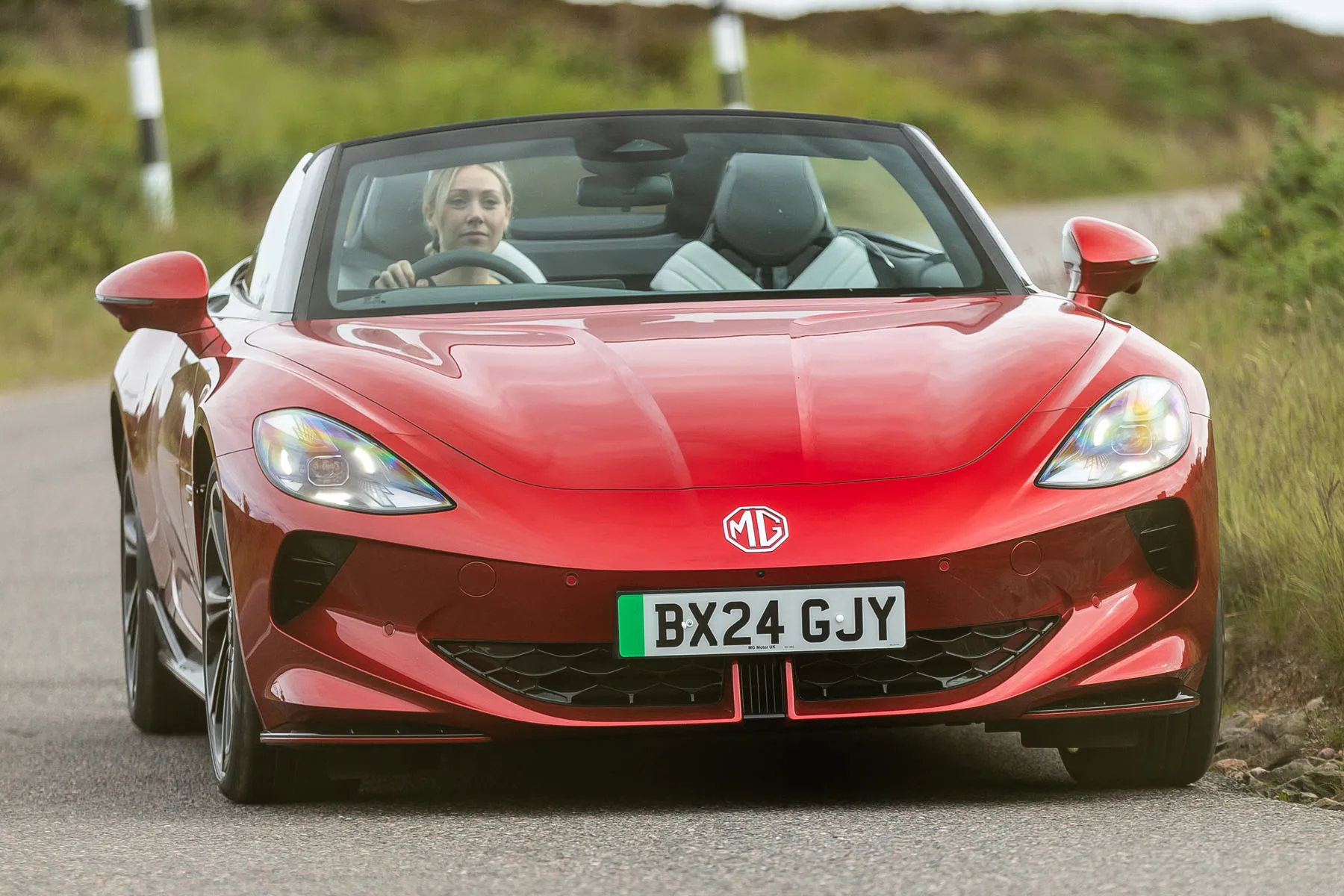
Let’s start with the entry-level Trophy version. The first important thing to note is that, like all electric cars have a tendency to be, the Cyberster is an extremely heavy car, the Trophy weighing in at 1,885kg. MG claims however, that this weight is distributed almost perfectly (49% at the front and 51% at the rear) for a good level of balance.
And sure enough, when you tip the car into a bend, it does a very commendable job of keeping its weight under control. Yes, you can feel that immense mass wanting to push the car sideways, but the body stays impressively flat, grip levels are immensely strong, and the car feels balanced and neutral. The steering also contributes to the feeling of alertness, because it’s responsive, reasonably quick and nicely weighted,even if you don’t get a great deal of genuine feedback. So far so good, then.
However, it’s also true that the suspension can struggle in other situations. Despite that impressive suppression of body lean in corners, there’s actually a surprisingly large amount of vertical movement in the suspension when you’re going in a straight line, and this has the body bouncing around unsettlingly over bigger bumps, dips and crests.
It doesn’t exactly spoil your fun, but it does give the handling a rather unruly character that isn’t really becoming, regardless of whether you see the Cyberster as a sports car, or more of a Grand Touring convertible. Either way, we feel that the handling should be rather more polished and precise than it is.
This pronounced vertical movement would be a bit more forgivable if the car gave a soft, cosseting ride, but it doesn’t, really. There’s a distinct tremble at low- and middling speeds that makes it feel rather pattery and unsettled. It stops short of being uncomfortable, but it could certainly be more relaxed. The ride improves the faster you go, though, so the Cyberster is a decent cruiser on the motorway.
Interestingly, the GT is a better car to drive than the Trophy, and not just because it has more power and speed, or because it further fine-tunes the front-to-rear weight distribution to a perfect 50-50. No. it’s mainly because you feel a shade less of that vertical movement in the suspension, possibly because the GT’s extra hardware means it carries an additional 100kg compared with the Trophy. This gives the car a more tied-down feel, so it feels generally more composed and controlled in terms of both handling and ride. Weight is often the enemy of dynamic polish, but in the Cyberster’s case, it might well be the thing that improves matters.
MG makes a lot out of the strength of the Cyberster’s Brembo brakes, and sure enough, they provide mighty stopping power. Provided, that is, that you give the pedal a good old shove. They have a rather wooden feel and are quite hard to modulate as a result, so when you’re braking, you’ll often find yourself having to push the pedal harder than you did to begin with because the car isn’t slowing as much as you expected it to.
What motors and batteries are available in the MG Cyberster?
Both versions of the Cyberster get the same 77kWh battery pack, but otherwise, the powertrains of the two versions are quite different.
The entry-level Trophy gets a single electric motor delivering 340PS to the rear wheels. The official 0-62mph time is given at a very handy 5.0 seconds, and the top speed at 121mph (a relatively low-sounding top speed is the norm on electric cars). The GT, meanwhile, gets an additional electric motor on the front axle - giving it four-wheel drive - and that hikes the total power output up to a supercar-worrying 510PS. The 0-62mph dash is trimmed to just 3.2 seconds, although the top speed only rises to 125mph. In both versions, the amount of power and torque you’re served up remains constant regardless of which driving mode you select, but the throttle mapping - in other words, the eagerness with which this power and torque is applied when you press the accelerator pedal - does vary.
So those are the numbers, but what about the sensation? Well, let’s begin with the Trophy, which feels appropriately rapid, and that applies whether you’re pulling away from a standstill or picking up speed on the move. The single-speed transmission also means that this pickup occurs in one steady, unbroken stream. However, the Trophy maybe doesn’t feel quite as rapid as its generous numbers would suggest, and the differences in throttle response make very little difference to the sensation of speed you feel in each driving mode.
Step into the GT, however, there’s a much bigger difference in sensation between the modes. Stick to Comfort mode and the GT doesn’t really feel all that much quicker than the Trophy in the way it picks up speed: rapid, sure, but not bonkers. However, set the driving mode to the maximum-attack setting, and the rate of acceleration you feel becomes a lot more explosive. It feels good for every ounce of that impressive 0-62mph time, and it has enough pace to worry far more expensive and exotic machinery.
Maximum electric range in the MG Cyberster
Both versions of the MG Cyberster get the same 77kWh battery capacity (74.4kWh usable). The official WLTP range of the Trophy version stands at 316 miles, while the GT model, with its bigger wheels and elevated power levels, has a theoretical range of 276 miles between charges.
Refinement and noise levels
You might detect a very slight whine from the electric motor(s) as you accelerate, but the noise is very distant - certainly more so than a combustion engine would be - and it’s also masked by synthetic noise that’s piped into the cabin. In Comfort mode, your acceleration is accompanied by a faint whooshing noise, while in the sportier modes, you’re served up a noise reminiscent of a distant four-cylinder petrol engine. We’re not sure that really in the spirit of things if you’re buying an EV - you’ll make your own mind up on how appropriate it is - but to be fair, it’s pretty inoffensive, and not as gimmicky as it sounds.
Road noise is fairly well contained at all speeds, but wind noise is quite prevalent with the roof up. When it’s down, you do feel a bit of wind buffeting in the cabin. You’ll be particularly affected by this if you’re much over six feet tall, because the high seating position puts the top of your head level with the top edge of the windscreen, and in the line of fire of the onrushing wind.
Safety equipment: How safe is the MG Cyberster?
The MG Cyberster hasn’t been crash-tested by Euro NCAP yet, and given that we expect it to sell in very low numbers, we’re not sure it ever will be. It shares a platform and parts with the MG4 hatchback, which scored the full five-star rating when it was tested back in 2022, but there’s only so much you can read into that given how different the cars are in other ways.
As standard, the Cyberster comes with an extensive suite of driver assistance measures known as MG Pilot. This brings together systems such as blind spot detection, lane change assist, lane keep assist, intelligent speed assist, traffic jam assist, front collision warning, rear cross traffic alert, and door opening warning.
Charging times: How much does it cost to charge the MG Cyberster?
“Hook your Cyberster up to a regular three-pin domestic socket - a ‘granny charge’ as they call it - and a 10% to 100% charge will take upwards of 31 hours. As a result, we wouldn’t recommend doing this on a regular basis, and it’s not good for your home’s electrics, either.”
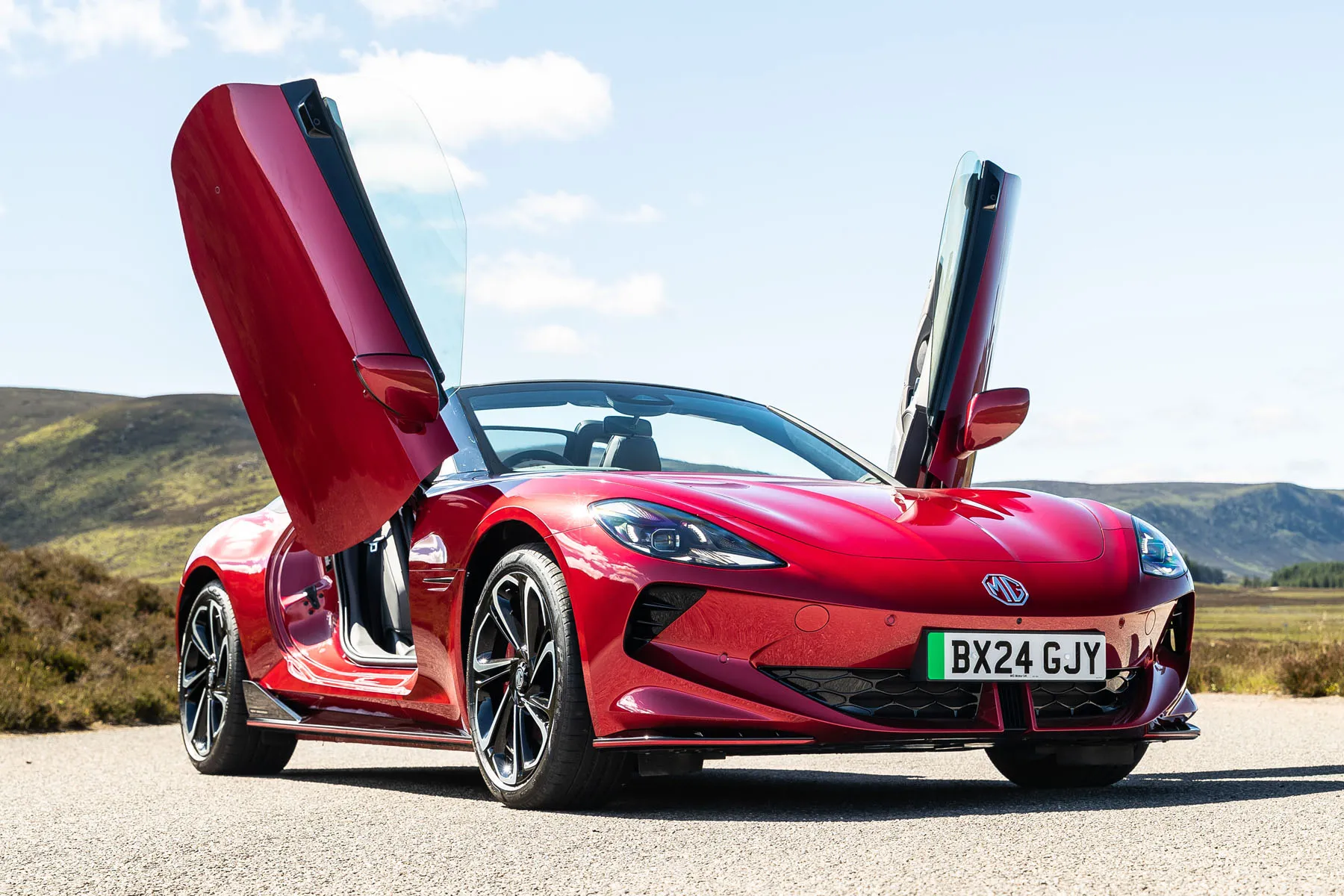
Do the advisable thing and get a 7kW wallbox charger installed at your home, and the same charge will be delivered in around ten and a half hours, which is much more like it.
Assuming that your home’s electricity is charged at the UK’s national average for the price of domestic power, and a full charge of your Cyberster’s 77kWh battery will cost you around £21. Get yourself on a domestic power tariff where you can charge your car on a discounted overnight rate, and you’ll easily cut that figure in half, if not even more.
The maximum rapid charging speed supported by the Cyberster is 144kW, so if you can find a powerful enough DC public charger, a 10% to 80% charge will be delivered in around 38 minutes. However, you’ll likely pay twice what you’ll pay for a full charge at home at the national average rate.
How reliable is a MG Cyberster?
With the MG Cyberster still being so fresh out of the box, there hasn't been time for any reliability issues with the car to come to light. It shares a platform and parts with the MG4 hatchback, and we haven’t heard of any reliability horror stories with that car, so hopefully that’s a good sign.
Look at the most recent HonestJohn.co.uk Satisfaction Index, and it tells a very middling story about MG. The brand placed 18th out of 29 carmakers for overall customer satisfaction, a distinctly middle-of-the-pack ranking. It didn’t feature in any of the study’s top 10 lists of the best cars in terms of both customer satisfaction or reliability, but it didn’t feature in the corresponding lists of the worst cars, either.
Like all MG models, the Cyberster comes with a generous warranty of seven years or 80,000 miles, whichever happens first. The service intervals on the car stand at 12 months or 15,000 miles, meanwhile.
Insurance groups and costs
The MG Cyberster is still very new, new enough that insurance groups for the car haven’t yet been announced. We’ll update this review once they are, but rest assured that with the level of power that both versions of the Cyberster have, insurance bills will not be cheap.
VED car tax: What is the annual road tax on a MG Cyberster?
At the time of writing (June 2024), the Cyberster - like all electric vehicles - is exempt from paying road tax. However, this exemption is due to be lifted in April 2025, so buying an electric car will save you very little tax from that point on.
Granted, the first-year tax bill will only be £10, but from the second year onwards, you’ll be paying the same flat rate of tax as drivers of petrol and diesel cars, a rate that currently stands at £190 per year.
What’s more, the exemption that EVs currently get from the ‘luxury car’ surcharge is also being lifted as of April 2025. This surcharge dictates that all cars that cost more than £40,000 when brand new must pay an additional sum on top of their regular annual tax payment between years two and six of the car’s life, a sum that currently stands at £410 per year. And because all Cybersters cost more than the threshold, all will be liable.
If you’re talking about benefit-in-kind company car tax rather than VED road tax, then the Cyberster immediately starts to make a huge amount of sense. If this car appears on your firm’s company car list, and you don’t need a car with family-friendly practicality, then you can have one of the most stylish convertibles on the road for a pittance of a monthly company car tax payment. That’s because electric cars are only liable for a fraction of the tax that combustion-engined cars are.
How much should you be paying for a used MG Cyberster?
"At the time of launch, the MG Cyberster costs around £55,000 for the Trophy model, while the GT will set you back around £60,000."
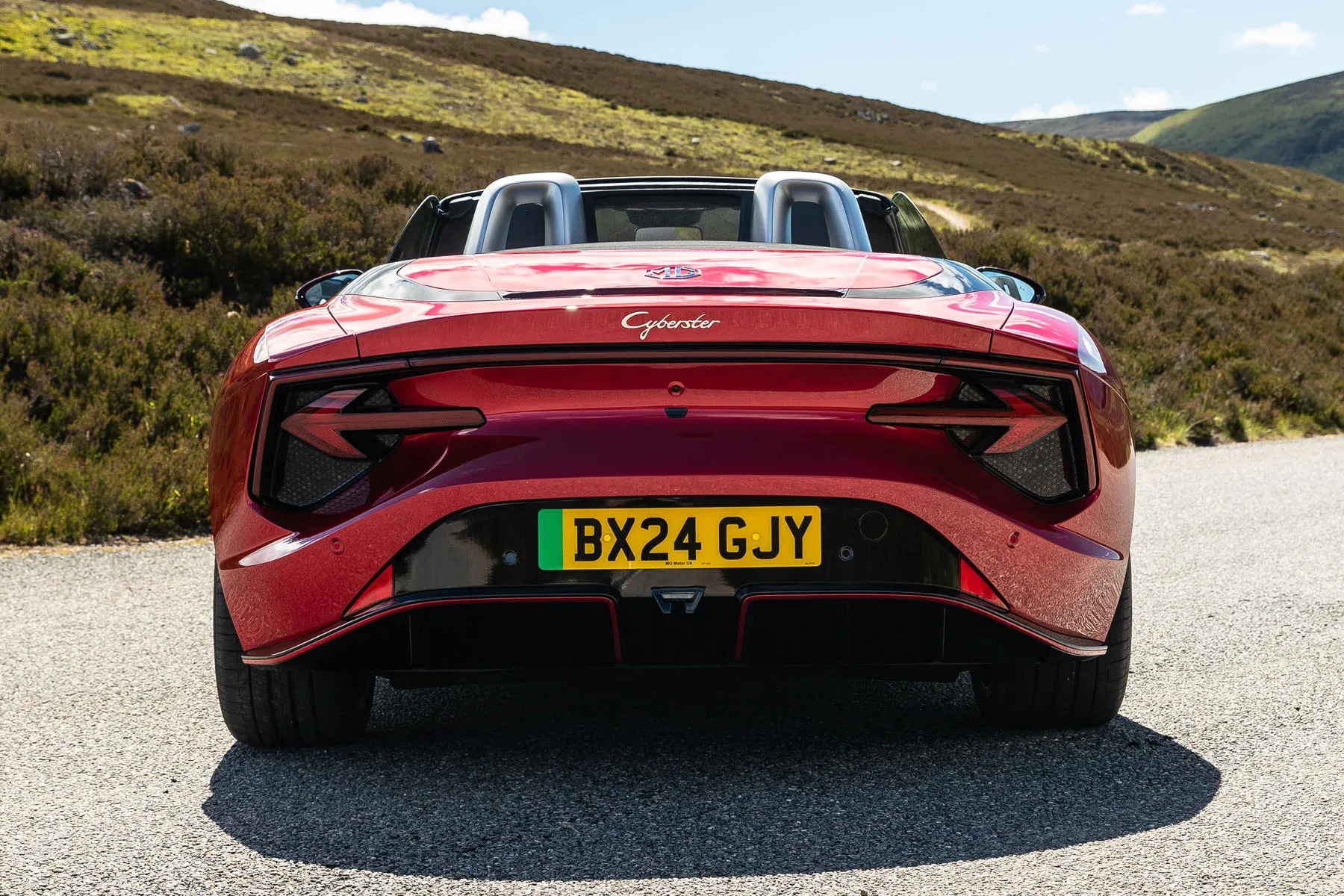
Granted, that makes it very expensive for an MG: at best, it’s around £20,000 more than MG's next most expensive model. However, it actually looks like very decent value when you compare it to the alternatives. Equivalently powered BMW Z4s and Porsche Boxsters cost quite a bit more - much more in the case of the Porsche - if you don’t mind a combustion engine. Electric sports cars - none of which are open-top, by the way - cost more still.
Trim levels and standard equipment
This is an area in which the Cyberster does really well, because the list of standard equipment is very generous. Both versions of the car have pretty much the same extensive kit list: the only difference between the two - apart from the power level - is the size of the alloy wheels you get, the Trophy having 19-inchers and the GT getting 20s. Indeed, looking at the numbers on the sidewall of the tyres is the only way to tell the two versions apart visually.
That means all owners get a fully electric hood, electric scissor doors, automatic lights and wipers, 360-degree parking cameras, keyless entry, and adaptive cruise control. Inside, the seats are heated, electrically adjustable and upholstered partly in man-made leather and partly in alcantara. You also get a heated steering wheel and dual-zone climate control.
The infotainment system, while complicated and distracting to use, does at least come with all the functionality you expect, including Bluetooth, DAB radio, navigation, voice control, Apple CarPlay, Android Auto and an eight-speaker Bose audio system.
You won’t be adding dozens of optional extras, either, because ease-of-choice is MG’s thing. A couple of the paint colours cost extra, while you can also choose the colour scheme of both your fabric hood and interior, but that’s about all the customisation you’ll be able to apply.
Ask the heycar experts: common questions
Is the MG Cyberster a good car?
Is the MG Cyberster electric?
Is the MG Cyberster cheap?
MG Cyberster Alternatives
Get our latest advice, news and offers
Keep me updated by email with the latest advice, news and offers from heycar.
By submitting you agree to our privacy policy
